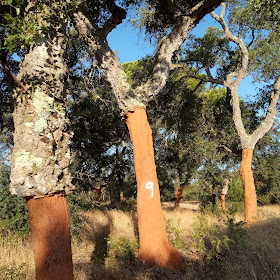A Tree with Conections
Quercus suber L
Since I was a young boy, I’ve always seen “sobreiros or chaparros” (portuguese name for cork oak trees) around. Being a Mediterranean kind of tree it can be seen all around the country - Portugal. It’s only when traveling south that you can see vast areas of woodlands where the cork tree is predominant. It’s called “Montado”.
 | |
| Typical Montado landscape |
I must ask you to forgive me, I’m being rude. Let me introduce myself.
Hello, my name is António. I’m from Portugal. As you may guess by now, Brian invited me to write a bit about cork trees. (I’ll send the money later Brian).
I’m lucky enough to live in a very tiny hamlet surrounded by woodlands. Some times it is quite scary because of how common forest fires are. During my morning walks with our crazy dog Luna, I like to talk to trees and take a few pictures. This summer I got lucky, some of the trees got undressed. It was the strip for the decade... (pause for reflection)
Nothing dirty I’m afraid.
Nothing dirty I’m afraid.
 |
| Just a couple of days after the stripping |
You see, the cork oak tree bark was “harvested.” That only happens to trees that are over 25 years old, and only once a decade. How do they keep track? Quite simple, a bit of white paint.
 |
| Defying gravity with a big burl |
No matter how many times I see it, it still amazes me. Taking a big chunk of the tree’s bark by hand with a special kind of hatchet (no pictures this time) and the tree’s fine with that for the next 150 to 200 years.
 |
| The little bush is a baby cork oak tree in the foreground |
The APCOR (Portuguese Cork Association) data reports that 33% of the cork bark worldwide production is located in Portugal and growing every year. A great deal of industry is reliant on the obvious and humble cork, such as insulation for construction, electronics, shoe industries, fashion industries (wallets, purses), even umbrellas, which are made out of cork because of the natural waterproof properties and natural fire resistance. The areas of Montado are simbiotic to other plant species, wild animals and small live stock like black pigs, goats or sheep that provide lovely and smelly tree food…
 |
| The same tree before and after the stripping. |
Last but not the least, the connection… Only when I began my woodworking journey did I discover that the cork tree is an oak cousin. It’s a thin one but they both belong to the Fagaceae family!
 |
| New tree alongside her mother |
In case you want to dig in a bit deeper, there are a couple of links in english:
https://www.apcor.pt/en/media-center/statistics/
Until next time,
Cheers to you all!

Thanks for writing this, António! It's well written and the pictures are beautiful. You are lucky to live in such a gorgeous place!
ReplyDeleteIt's kind of hard to see, but do the leaves look like typical oak leaves?
A big white "9" is a super idea. That means next time it's cut is 2029. Is it common for all the trees in a field are harvested at the same time?
Yes the trees are striped around 9 to 10 years, the companies keep records about the fields, and check the trees.
DeleteIn this area depending on the weather this could be done in 9 or 10 years.
Plus after the harvest the bark will "rest" to reduce moister for 6 months before gets a proper wash and selection to each industry.
Amazing. I never knew about any of this before. I knew cork came from cork trees, but that's about it.
DeleteAre plastic wine corks good or bad for the cork tree industry? It seems that plastic corks aren't just for cheap wine anymore.
Its like comparing apples to oranges. Both are fruit as they are both corks and that's it!
DeleteCork tree industry is an all different level
Thank you very much for the opportunity Brian.
ReplyDeleteThis was a pleasure.
Good stuff - I love this kind of post. I learned something today! And I'm glad the industry is good about keeping to its limits on harvesting. I'm sure that if these trees grew in America, they would figure out how to fertilize with horrible chemicals that would allow them to harvest annually, at the cost of giving every other plant, animal and insect cancer in the process. (I'm not too jaded, am I?)
ReplyDeleteI'm glad you like it. Cheers mate
DeleteGreat stuff Antonio.
ReplyDeleteVery interesting tidbit of information. I knew that most corks came from Portugal, but that was about the extend of my knowledge.
Looking forweard to you next post Antonio.
Good on you to do that Brian, thanks
Bob, who learned something
Interesting read and great images. Now that this is a woodworking blog, the next obvious question would be: How is the wood it self like to work with?
ReplyDeleteGood point Ty Stange.
DeleteAlready talked with Brian and we should have a follow up blog soon!
So stick around to read all about it!